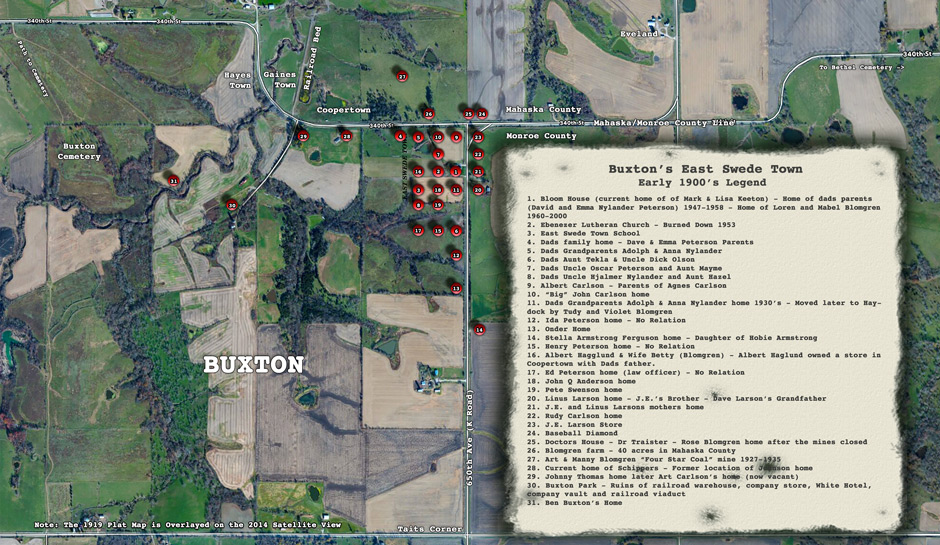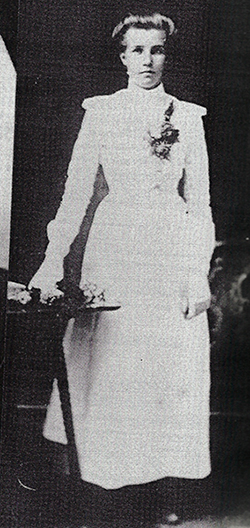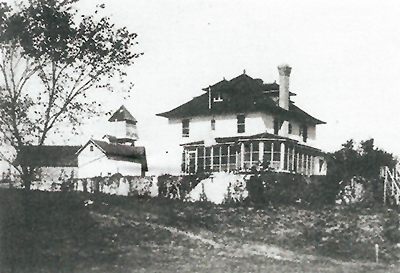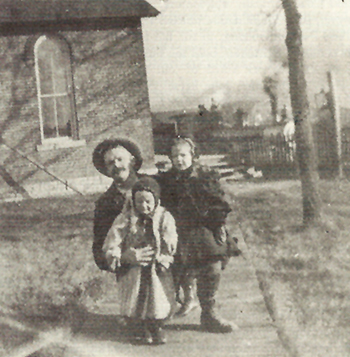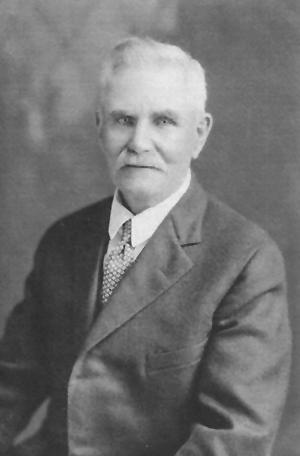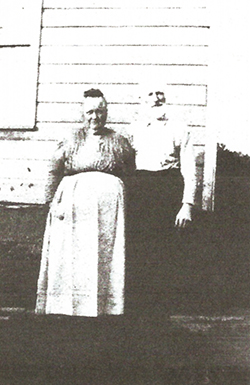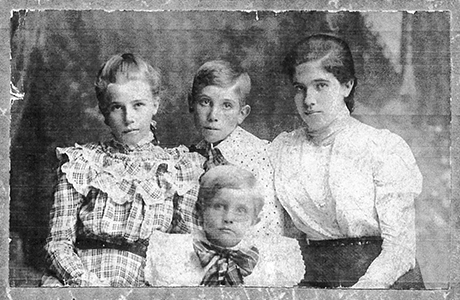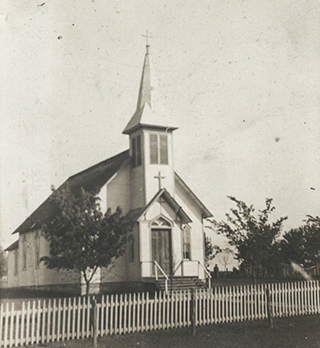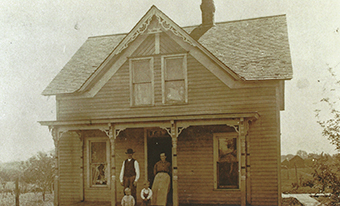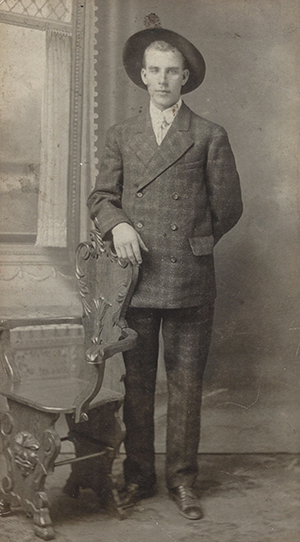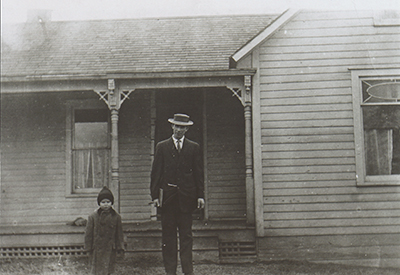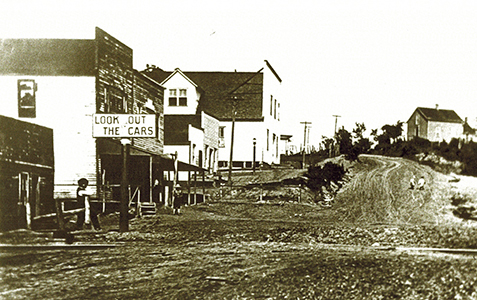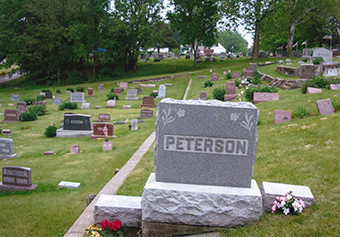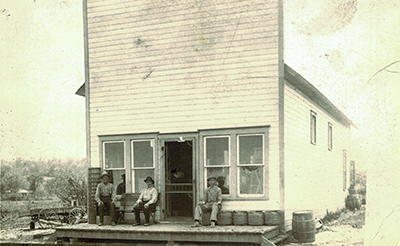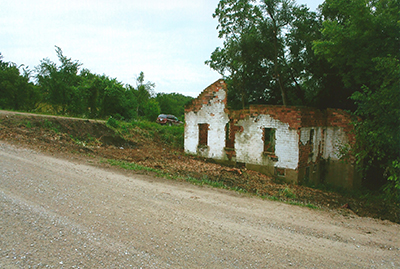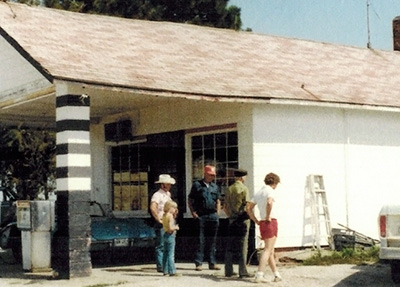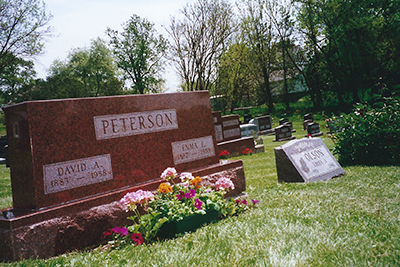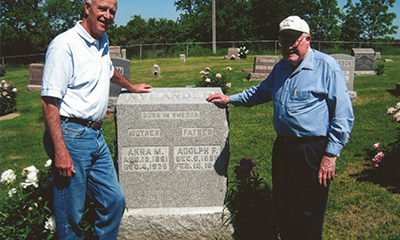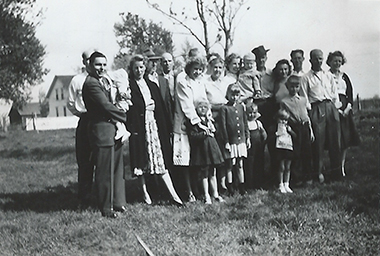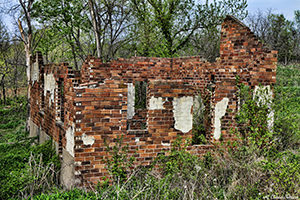
http://www.buxtoniowa.com • Consol, Haydock & Buxton Iowa, USA • 1871 - 2014
Buxton's Housemaid Emma Nylander-Peterson
My grandmother, Emma Nylander Peterson, was a house maid in the Ben Buxton family home in the coal mining camp of Buxton, Iowa. Mr. Buxton was the mine superintendent for the Consolidation Coal Company from 1896 to 1909. The Buxton home was located to the west of what was considered downtown Buxton (currently 102nd Lane) and across Bluff Creek. The house was built in the early 1900s, about the time Mr. Buxton was relocating the Consolidation Coal Company’s Muchakinock coal mining camp to the Buxton coal mining camp.
Grandma completed her schooling in 1905 and married David Peterson in 1908. It would have been during the period between 1905 to 1908 that grandma was a maid for the Buxton family. My thought is that she was a live-in maid at the Buxton’s home since the home of her parents, Adolph Fredrick and Anna Nylander, was located along the Monroe/Mahaska County Line Road in what was called Buxton’s East Swede Town.
It wasn’t until after Grandma died in 1959 that I learned she had been a maid for the Buxton family. Aunt Naomi, my grandparents eighth child, gave me a souvenir spoon that had been in Grandma’s treasure chest. When Aunt Naomi gave me the spoon, she told me the history of the spoon and that Grandma was a maid for the Buxton family. The spoon was a souvenir from a trip to Seattle that Grandma took with the Buxton family. She undoubtedly was on the trip to help care for the Buxton children. What a trip it must have been, traveling by train across the West in the early 1900s. I have passed along the spoon to my granddaughter, Emma Strong, who was named after Grandma.
The coal mining camp of Buxton grew to a population of well in access of 5,000 inhabitants (some say as high as 10,000). I call Buxton a coal mining camp because it existed for a mere two decades before it was abandoned and buildings were moved, including the miners homes, in camp fashion. I am quite certain the Nylander and Buxton families were well acquainted. Adolph “Fred” Nylander, grandma’s father, was very involved in the development of Buxton and especially Buxton’s East Swede Town area.
The fact that Mr. Buxton allowed the Swedes in East Swede Town to have one acre lots, instead of the 1/4 acre lots typical throughout the rest of Buxton. This would have involved Grandma’s father, Adolph, talking a great deal with Mr. Buxton. Residents of East Swede Town were permitted to build and own their own homes on the lots they leased from the coal company. The lots rented for $.50 per month. Other than in East Swede Town, the Consolidation Coal Company owned virtually all of the other homes in Buxton proper.
Grandmother was born in 1887 in the Muchakinock, Iowa coal mining camp. According to Grandma’s birth certificate, the midwife who delivered grandmother was Mary Chambers. Mary delivered hundreds if not thousands of babies between the mining camps of Muchakinock, Haydock and Buxton. She was the great aunt of Francis Butcher. The Butcher and Peterson families became very close friends in Haydock. Midwives were quite common in that era due to, I am sure, the lack of availability of Doctors. Francis Butcher’s remembrances of Haydock can be read by clicking here.
The Muchakinock camp was located five miles directly south of Oskaloosa on the road (currently Highway 169) to Eddyville. Grandmother’s parents and older sister, Tekla, immigrated to Muchakinock, Iowa from Flipstad, Sweden in 1884. Grandma had two younger brothers, Hjalmer (b.1889) and Henry (b.1893). Her father was associated with the mines and the Consolidation Coal Company as a carpenter. As a carpenter, he was very involved in moving the Ebenezer Lutheran Church building by rail from Muchakinock to Buxton’s East Swede Town in 1900, a distance of nearly 15 miles. The Adolph and Anna Nylander family of six moved from Muchakinock to Buxton’s East Swede Town at that same time.
The Nylander home was unique in design as compared to the company owned homes in the rest of Buxton. The home design was a reflection of Adolph’s carpentry skills. Grandmother’s parents remained living in Buxton’s East Swede Town until their deaths, Anna in 1928 and Adolph in 1941. This, in spite of the town becoming a ghost town and the Buxton’s coal mines being closed by the mid-1910s.
After Grandma Emma and Grandpa Dave were married, they lived in a home near her parents Anna and Adolph Nylander in East Swede Town. Grandpa Peterson had immigrated from Varmland, Sweden in 1903. Grandpa’s brother Oscar Peterson had already immigrated to America. Grandpa went to Cripple Creek/Victor, Colorado for a short time to work in the gold mines before returning to Buxton to marry Grandma. Shortly after marrying Grandma, Grandpa was crippled when slate fell on him in a mining accident. He then found work as a grocer with the J.E. Larson grocery store in East Swede Town. He took orders and delivered groceries by horse and buggy.
Grandpa Peterson started a grocery store two years later in Coopertown, a Buxton suburb, with his brother Oscar’s wife Mayme’s brother, Albert Hagglund. The store was destroyed by fire in 1916 along with a number of other buildings in Coopertown. In that same time frame, the coal mines in the Buxton coal fields were being depleted. Rather than rebuild in Coopertown, Grandpa opened a store 20 miles to the southwest in the Consol coal fields. The Consol coal mining camp was one mile north of mine #18 of the Consolidation Coal Company. Grandpa was the Consol Post Master. The post office was located in the front of the Peterson Store in Consol. Click here to access my story on the Consol Post Office and Peterson Store.
The David and Emma Peterson family consisted of six children (Irving, Ray, Ivan, Linnea, Elizabeth, and Wilma) when they moved to Consol. Three other children, Naomi, Bernie and Ruth Pauline, were then born in Consol. Sadly, in 1922 Irving died of blood poisoning from stepping on a nail and Ruth Pauline lived only one month after her birth.
By all accounts the store in Consol was very successful. The store was in an excellent location in Consol next to the Falvey Bros. Lumber Yard. Grandpa was also able to service the Bucknell coal mining camp that was located four miles by road to the west. The Consolidation Coal Company mine #19 was located in Bucknell. When commuting from the Consol store to Bucknell in 1921, Grandpa was robbed of $700 while on “Maddy’s Hill”. $700.00 was a lot of money when the average household income at that time was not much more than $1,000 per year. The lonely road between Consol and Bucknell at night wouldn’t have been the safest place to travel. Grandpa’s oldest 13 year old son, Irving, was with him. What an experience that must have been for Irving.
In 1922, the coal company expanded further west from Bucknell to a new coal mining camp called Haydock. It became obvious that Grandpa would need to move his store from Consol to Haydock. My grandparents were able to build a brick home and store in an excellent location in Haydock, called Midway. Midway was on the dividing line between Bucknell and Haydock. The dividing line was 527th Avenue, which was commonly referred to as the Melrose Road since Melrose was 6 miles straight south.
Roy, the youngest child born to David and Emma Peterson, was born in 1924 in Haydock. My dad, Ray, being the oldest living child after his brother died, quit school after the eighth grade to help with the store. As a14 year-old, Dad drove the delivery truck to pick up grocery supplies in Chariton and to make home deliveries around Haydock and Bucknell. The Peterson family was a happy family. They lived in a very nice new brick home with an electrical generator in the basement. The children were attending the new Bucknell High School that was located on the West end of Haydock.
Within five years, their lives changed drastically. The Consolidation Coal Company sold its mining operation to the Superior Coal Company of Gillespie, Illinois. All of the plans to develop a “great industrial city” by opening mine #20 and moving the coal company’s headquarters to Haydock were abandoned. When in 1927 the salaried workers at the coal company were asked to take a pay cut, they went out on strike. The mine workers honored the strike. With that the coal company closed mines #18 and #19 and moved its coal mining operation to the Gillespie, Illinois area. With the closing of the mines, as I wrote in my article “The Haydock Peterson Store, Its Legacy,” the store was the lifeblood with food for the families of the miners as they hoped that the mines would be reopened. That wasn’t to be as miners and their families fled the area for work in the larger cities in Iowa including Waterloo, Cedar Rapids, and Des Moines.
With the area in their blood and home to them, Grandma and Grandpa remained in Haydock until 1942 when they went to help with the WWII war efforts by working in the ship yards of Richmond, California in the San Francisco/Oakland area. During the period from 1927-1942, in order to support the family of ten, Grandma ran the Haydock store while Grandpa built and opened stores along the newly paved Highway 34 in Georgetown and the Melrose Corners. (The Melrose Corners store was sold to the Parenza’s in 1932.) The Bucknell High School remained open until 1935. Most of the Peterson children were able to complete high school before the school closed.
After the end of the war in 1945, Grandma and Grandpa returned to where else but Buxton’s East Swede Town. East Swede Town would be their home until their dying days in the late 1950’s.They farmed the very land that once was East Swede Town. It required plowing around the abandoned wells of the miner’s homes. Grandma’s sister Tekla (Richard)Olson and family lived in their home in East Swede Town for over 60 years. Her brother Hjalmer (Hazel) Nylander lived and farmed around Bussey. Grandpa’s brother Oscar (Mayme) Peterson and family lived in Chariton. It is interesting to me how so many of the East Swede Town families remained in Monroe County after the coal mines were closed. The Blomgren, Olson, Larson, Carlson, Johnson, Nylander and Peterson families come to mind. Many to this day still have family in the area. Dave and Liz Larson and their daughter Lisa(Mark) Keeton are farming land that has been in the Larson family for over 100 years.
After Grandpa and Grandma Peterson died in the late 1950s, the void was filled for my Dad and me by annually decorating the graves of relatives buried in cemeteries in and around Bethel, Albia and Oskaloosa. Every Memorial Day Dad and I would journey to Oskaloosa and Muckakinock where Grandma was born, stop at the Bethel cemetery at the grave sites of Grandma’s parents, Adolph “Fred” and Anna Nylander, visit Buxton Park and the remains of downtown Buxton, visit with Manny Blomgren and his daughter Mabel and son Loren who lived in the Bloom house after Grandma and Grandpa Peterson died. We would then visit the graves in the Albia Oak View cemetery including those of my grandparents David and Emma (Nylander) Peterson, Grandpa’s brother John Peterson and the Peterson children Irving and Ruth Pauline.
I always enjoyed visiting with Manny Blomgren. He had been the pit boss in the mines. He told me that he picked up Grandpa Peterson at the train station when Grandpa first came to America in 1903. Most likely it was by horse and buggy. Manny would always give dad and me a treat when we visited him- a Hershey candy bar.
Dad liked to visit his cousin Edna (Aunt Tekla’s daughter) and her husband Carl Blomgren in Albia. The trip was never complete until we stopped at the North End Tavern in Lovilia where we would have a cold drink and remember when the building was the Consol post office and the Peterson Store in Consol.
Grandma Emma was like most of the women of the Coal Dust Era in the coal mining camps. The women worked hard and long hours and were under appreciated. In spite of all of the difficulties they were loving and caring. They accepted the lives they lived without feeling sorry for themselves. Grandma Emma exemplified the lives of most of the mothers and wives of that era. They were very special.
After the major producing coal mines closed in 1927 and the coal camps were deserted by nearly all of the miners, the Peterson family remained in the Haydock coal mining camp until 1942. Newspaper articles were written about the hard life of living in coal mining camps. One article in particular was written about the Peterson family and their hardships in living in coal mining camps for nearly a half a century. The article upset Grandma, because she never thought of her family being any worse off than other coal mining camp families. To Grandma, her life was one of celebration.
I remember with fondness the Peterson/Nylander family reunions at the Bloom house in Buxton’s East Swede Town in the late 1940s and early 1950s. What joyous occasions they were. Grandma was right; the coal mining era was one for celebration of lives well lived and loved. When grandma died at the relative young age of 72 years, she had lived in coal mining camps or what once was coal mining camps for 70 years.
I like to reflect back to the many trips I made from my homes in Charles City, Iowa and Minneapolis to those Monroe County coal mining camps when my Grandparents were alive, later with my parents and brother and sister and eventually with my own daughters. My cousin Carl Virgil Blomgren of Overland Park, Kansas and I have often returned together to our family roots. I recall one trip in the 1990’s with my Dad’s sisters Naomi and Linnea. Since it had been well over 60 years since Aunt Naomi had been back to Haydock/Bucknell, she wasn’t able to recognize where she had lived growing up. The Haydock/Bucknell coal mining camp that once was home to nearly 5,000 was now heavily forested with the only evidence of the once coal mining camps was the still standing brick wall ruins of her families home.
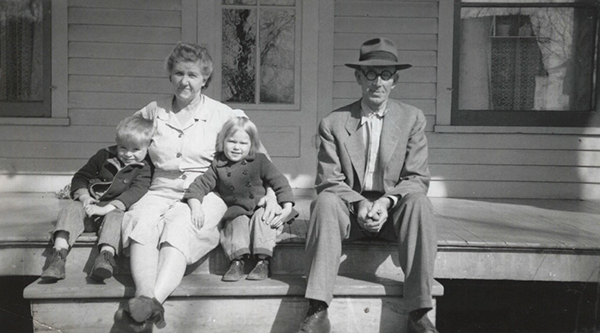
A cherished 1942 photo of my sister Barbara Larsen and me with our grandparents,
Emma and David Peterson, on the front porch of our home at 1310 F Street in Charles City, Iowa.
For me, the joy of getting old is recalling. In recalling my family roots in those coal mining camps I feel like I once lived there. I feel their joy and pain, the hardships and their strength and dedication to family and their love for each other and for a place they once called home. A place called Buxton.
